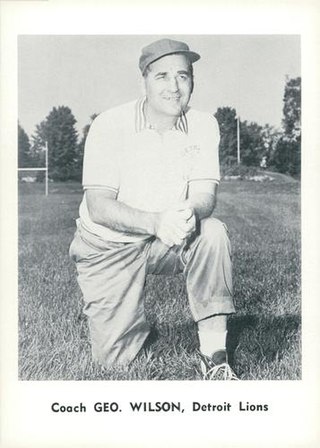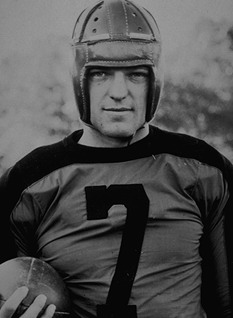Related Research Articles

Harold Edward "Red" Grange, nicknamed "the Galloping Ghost" and "the Wheaton Iceman", was an American football halfback who played for the Chicago Bears and the short-lived New York Yankees. His signing with the Bears helped legitimize the National Football League (NFL).

Ernest Alonzo Nevers, nicknamed "Big Dog", was an American football and baseball player and football coach. Widely regarded as one of the best football players in the first half of the 20th century, he played as a fullback and was a triple-threat man known for his talents in running, passing, and kicking. He was inducted with the inaugural classes of inductees into both the College Football Hall of Fame in 1951 and the Pro Football Hall of Fame in 1963. He was also named in 1969 to the NFL 1920s All-Decade Team.

Gale Eugene Sayers was an American professional football halfback and return specialist in the National Football League (NFL). In a relatively brief but highly productive NFL career, Sayers spent seven seasons with the Chicago Bears from 1965 to 1971, though multiple injuries effectively limited him to five seasons of play. He was known for his elusiveness and agility and was regarded by his peers as one of the most difficult players to tackle.

Peter Louis Pihos was an American football player and coach.

Charles Robert Taylor was an American professional football player who was a wide receiver for 13 seasons with the Washington Redskins of the National Football League (NFL). After playing college football for the Arizona State Sun Devils, he was selected by Washington in the first round of the 1964 NFL draft. With Taylor, the Redskins made the playoffs five times and reached the Super Bowl once (VII), after the 1972 season. A six-time All-Pro and eight-time Pro Bowl selection, he was inducted into the Pro Football Hall of Fame in 1984.

Joseph Lee Stydahar nicknamed "Jumbo Joe", was an American football player and coach. He was inducted into the Pro Football Hall of Fame in 1967 and the College Football Hall of Fame in 1972.

George William Wilson, Sr. was a professional football end and later a coach for the National Football League (NFL)'s Detroit Lions and the American Football League (AFL)'s Miami Dolphins. Wilson attended and played football at Northwestern University. He went undrafted in 1937, before being signed by the Chicago Bears. Wilson played for ten seasons with the Bears, compiling overall record of 111 pass receptions, 1,342 receiving yards, and fifteen touchdowns. He was a member of the Bears during their five appearances in the National Football League Championship Game from 1940–1943 and 1946. Additionally, he was selected for the NFL All-Star Game from 1940–1942. He also played one season of professional basketball for the Chicago Bruins in 1939–40. Wilson won seven championships combined as a player and coach.

William Ernest Hewitt was an American football defensive end and end who played in the National Football League (NFL). He played five seasons for the Chicago Bears (1932–1936), three for the Philadelphia Eagles (1937–1939), and one for the Phil-Pitt Steagles (1943). He is remembered for his refusal to wear a helmet as one of the last NFL players not to wear one.

Earl Harry "Dutch" Clark, sometimes also known as "the Flying Dutchman" and "the Old Master", was an American football player and coach, basketball player and coach, and university athletic director. He gained his greatest acclaim as a football player and was inducted into the College Football Hall of Fame with its inaugural class in 1951 and the Pro Football Hall of Fame with its inaugural class in 1963. He was also named in 1969 to the NFL 1930s All-Decade Team and was the first player to have his jersey retired by the Detroit Lions.

John Leo "Paddy" Driscoll was an American football and baseball player and football coach. A triple-threat man in football, he was regarded as the best drop kicker and one of the best overall players in the early years of the National Football League (NFL). He was inducted into the Pro Football Hall of Fame in 1965 and the College Football Hall of Fame in 1974.

Kenneth William Kavanaugh was an American football player, coach, and scout. He played professionally in the National Football League (NFL) for the Chicago Bears as an end from 1940 to 1950, except for three seasons during which he served in World War II. He led the league in receiving touchdowns twice, and is a member of the NFL 1940s All-Decade Team. He is the Bears' all-time leader in receiving touchdowns, with 50. He retired with the second most receiving touchdowns in NFL history and was the second to reach 50 touchdowns in NFL history.

James Warren Benton was an American football player. He played professionally in the National Football League (NFL) with the Cleveland / Los Angeles Rams and the Chicago Bears between 1938 and 1947. Benton was the first NFL receiver to gain more than 300 yards in a game, a record that stood for 40 years. He was selected for the National Football League 1940s All-Decade Team.
The 1933 NFL Championship Game was the first scheduled championship game of the National Football League (NFL) since its founding in 1920. It was played on December 17 at Wrigley Field in Chicago, and the attendance was estimated at 25,000.
The 1925 Chicago Bears season was their sixth regular season completed in the National Football League. The team was unable to improve on their 6–1–4 record from 1924 and finished with a 9–5–3 record under head coach George Halas earning them a seventh-place finish in the team standings, their worst showing to that date. However, the 1925 Bears were the most notable team in the young NFL's history to that point all because of the addition of college players, including Red Grange.
The 1933 season was the Chicago Bears' 14th in the National Football League and the 11th season under head coach George Halas. The team was able to improve on their 7–1–6 record from 1932 and finished with a 10–2–1 record.
The 1937 Chicago Bears season was their 18th regular season completed in the National Football League. The Bears started the season fast, winning their first five games, three of them on the road. After a tie to the Giants and a loss to the Packers, the Bears finished the season strong, winning their last four games. The team was second in scoring offense, behind Green Bay, and led the league in scoring defense.

Robert Mann was an American professional football player in the National Football League (NFL). A native of New Bern, North Carolina, Mann played college football for the Hampton Pirates in 1942 and 1943 and the Michigan Wolverines in 1944, 1946 and 1947. Playing the end position, he broke the Big Ten Conference record for receiving yards in 1946 and 1947. After not being selected in the 1948 NFL draft, Mann signed his first professional football contract with the Detroit Lions, where he stayed for two seasons. He later played for the Green Bay Packers for parts of five seasons until 1954. Mann broke the color barrier for both teams.
David Hinton Middleton was an American football end, wide receiver, and halfback.

William Edward Royal is an American former football wide receiver and return specialist. He was selected by the Denver Broncos in the second round of the 2008 NFL draft. He played college football for the Virginia Tech Hokies and was elected to its sports hall of fame in 2018. Royal also played for the San Diego Chargers and Chicago Bears.

Elmer Kenneth Strong was an American professional football player who was a halfback and fullback. He also played minor league baseball. Considered one of the greatest all-around players in the early decades of the game, he was inducted into the College Football Hall of Fame in 1957 and the Pro Football Hall of Fame in 1967 and was named to the NFL 1930s All-Decade Team.
References
- 1 2 3 4 5 6 "Bill Karr". Pro-Football-Reference.com. Sports Reference LLC. Retrieved September 17, 2019– via Newspapers.com.
- ↑ "Mountaineers in Moleskins". Uniontown, Pa., News-Standard. October 5, 1932. p. 9 – via Newspapers.com.
- ↑ "Bears Whip Giants, 23-21; World Champions; Score With 3 Minutes To Go Decides Battle". Chicago Tribune. December 18, 1933. pp. 23, 25 – via Newspapers.com.
- ↑ "The Story of the Big, Bad Bears: Coach Halas Names the 11 Best Players Who Have Worn Bear Uniforms". Chicago Tribune. October 28, 1941. p. 21 – via Newspapers.com.
- ↑ Arch Ward (January 11, 1939). "In the Wake of the News". Chicago Tribune. p. 19 – via Newspapers.com.